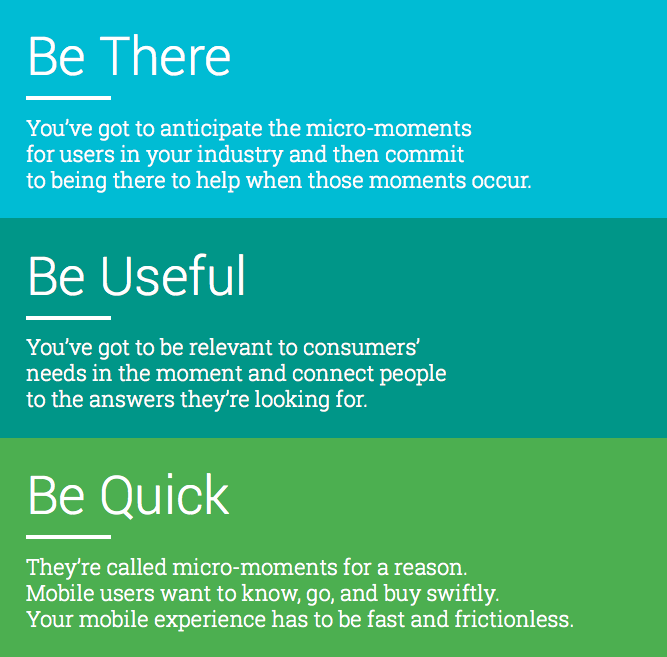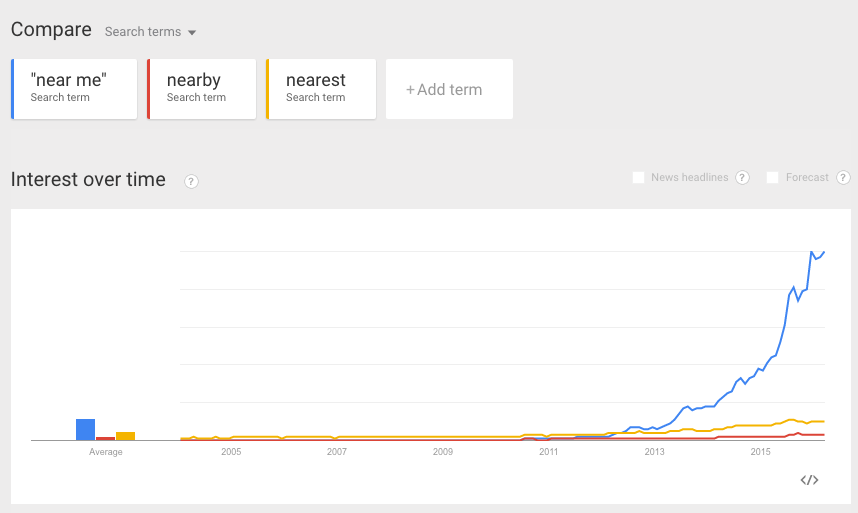In the past year or so Google has published numerous articles and research around the topic of ‘Micro-Moments’, which it describes as “the new battleground for brands”.
Let’s look at a top level overview and then we’ll explore a few ideas around how to optimise one particular micro-moment.
So what are ‘micro-moments’, exactly?
Google says they are “critical touch points within today’s consumer journey, and when added together, they ultimately determine how that journey ends.”
It points to the use of mobile as a key driver of searches that reflect a consumer’s micro-moment, and it says brands need to be ready for them.
“These I-want-to-know, I-want-to-go, I-want-to-buy, and I-want-to-do moments are loaded with intent, context, and immediacy.”
All of which sounds marvellous, if you know your search onions.
There are numerous stats to help focus minds, should you need to convince colleagues or clients. These stats come from a survey Google conducted in the US last August (they undoubtedly reflect wider trends in the more mature mobile markets).
- 91% of smartphone users turn to their phones for ideas when in the middle of a task
- 90% are not certain of the brand they want to buy from
- 82% use their phones to check on prospective in-store purchases
- 65% look for the most relevant information to their query, regardless of the company that provides the answer
- 51% have discovered a new company or product when searching on their phone
- 33% have purchased from a different brand than the one they had in mind, because of the information provided
In summary, when it comes to finding answers, mobile searchers are a) very active and b) not brand loyal.
This is a huge opportunity, especially as the mobile search land-grab is still underway, with many firms lagging behind due to poor mobile user experiences.
The advice? It’s all about anticipation, relevance and ease of use…
An example of ‘Be There’ would be around location.
Consider the growth in ‘near me’ searches. These are when the user adds ‘near me’, ‘nearby’ and nearest’ in their queries. Google says that ‘near me’ searches have doubled in the past year.
If you look back a little further, it would appear that these searches have skyrocketed since 2013, with ‘near me’ growing 15-fold.
Google Trends needs to be taken with a little pinch of salt, not least because it the volumes indicated are relative rather than absolute, but any which way you look at it, that’s huge growth.
How to optimise for ‘near me’ searches
I won’t go into too much detail here, but you can dig into these seven areas for starters.
Do the basics
As in, have a properly structured, highly usable website, with some excellent content and technically optimised for the search engines. Make sure it you create a frictionless user experience across all devices. If you run an ecommerce operation then this is a very good read.
Optimise your existing footprint (or create a new one)
Google looks for a bunch of basic information about your business to display within its local listings. Things like contact information (address, phone number, email), a map (e.g. Google Maps), opening hours, customer reviews, and so on. Use schema markup for extra brownie points.
Set up local business listings
Moz Local can prove helpful in this respect a lot. In fact, David Mihm’s slides from last September’s Brighton SEO event are a goldmine of insight in this area.
Get lots and lots of reviews, and then get some more
Google is increasingly paying attention to reviews, and with good reason. A Brightlocal survey on the subject last August found that only 11% of consumer don’t take any notice of them. Quality and velocity matter. I feel that most brands – especially offline companies – don’t do enough to secure customer feedback, even when we know it is a crucial part of Google’s local search algorithm. I also think that Google will uprate social ranking signals in the years to come.
Undertake a local search audit
There are a number of tools that you can use to analyse local rankings, to figure out how to get one over your competitors.
Get more local links
Make friends with the community! There are plenty of ways of attracting links from local sites. Think about events, directories, local news sites, awards, schools and colleges, non-competing companies, and so on.
Add ‘near me’ copy on your pages
Does this really work? Colleen Harris at CDK Global investigated whether this would help by undertaking a study of 82 auto dealers over a five month period. She found that those that added ‘near me’ content increased clickthroughs by 81%, compared with those that didn’t (8,833 clicks vs 4,365 clicks). Impressions increased too, though by just 15%. Good enough!
In summary
Google is going big on micro-moments, and there are a ton of articles and studies to explore over at its Think With Google site.
It’s true that many companies have a lot more work to do in terms of understanding the consumer journey, and that the mobile user experience on many sites leaves a lot to be desired. But there’s a lot to play for, and the guidance issued by Google – as well as the countless algorithmic and search UI tweaks – suggests that it is now essential to get on top of this stuff.
Have you had any success with optimising your site for micro-moments? Do leave a comment below…
The article The rise of ‘Micro-Moments’ and how to optimise for ‘near me’ search queries was first seen from https://searchenginewatch.com



No comments:
Post a Comment